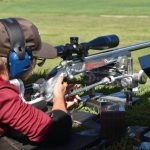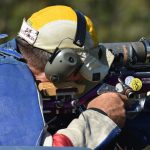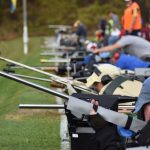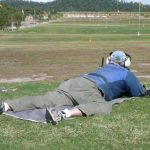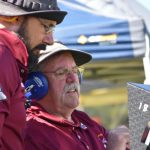ANZAC DAY 2019
BRUCE A. R. SCOTT, CSC, ADC
ANZAC DAY ADDRESS
BELMONT RIFLE RANGE – 25 APRIL 2019
BRUCE A. R. SCOTT, CSC, ADC
As the grandson of a Western Front veteran, the grandnephew of a Gallipoli veteran, a recently retired contemporary veteran, the Colonel Commandant of the Royal Queensland Regiment and an active Queensland rifle shooter and administrator, my address today will unashamedly highlight the commitment and sacrifices made for our country by our dedicated rifle club members during the Great War.
The Great War was the biggest event in Australia’s history. We were a true and loyal contributor to the Empire’s cause – almost half of our eligible males enlisted, and the casualties were enormous in raw and in national terms. In terms of total deaths per 1,000 men mobilised, the AIF figure was 145, the highest of all the British Commonwealth armies. There was hardly a family in Australia that was not touched by the Great War.
In 1914 Australia had a population of about 4.75 million and of these, 417,000 men (about 10%) enlisted in the AIF of whom 330,000 served overseas. 60,000 were killed or died from all causes, 137,000 were wounded and 4,044 were captured (397 died while captives).
Out of every 10 Australians who served abroad, five were wounded (many more than once) and two died on active service. Many of those who returned home were disfigured or disabled and those who were not physically injured, suffered from terrible memories, nightmares and other psychological scars that led them to withdraw from friends and family, turn to drink, or quietly suffer alone. There would be few Australian families today who would not have some family connection to the Great War. My grandfather fought with Monash’s Division in France and my great uncle was a sniper at Quinn’s Post on the Gallipoli Peninsular.
Australia’s involvement in the Great War began when Britain and Germany went to war on 4th August 1914, and both Prime Minister Joseph Cook and Opposition Leader Andrew Fisher, who were in the midst of an election campaign, pledged full support for Britain. The outbreak of war was greeted in Australia, as in many other places, with great enthusiasm.
The first significant Australian action of the war was the Australian Naval and Military Expeditionary Force’s landing on Rabaul on 11th September 1914. The ANMEF took possession of German New Guinea at Toma on 17th September 1914 and of the neighbouring islands of the Bismarck Archipelago in October 1914. I will talk more about the ANMEF shortly as it is very relevant to the Queensland rifle clubs of the day. On 9th November 1914 the Royal Australian Navy made a major contribution when HMAS Sydney destroyed the German raider SMS Emden in the vicinity of the Cocos Islands.
On 25th April 1915 members of the Australian Imperial Force (AIF) landed on the Gallipoli Peninsular in Turkey with troops from New Zealand, Britain, and France. This began a campaign that ended with an evacuation of allied troops beginning in December 1915. The next year Australian forces fought campaigns on the Western Front and in the Middle East. The Great War ended on 11th November 1918.
What is the connection between the two rifle associations in Queensland and their members and the Great War? I will explain.
Prior to Federation, the early schemes for Australia’s defence reflected the obsolete attitudes of the wider British Empire under the reign of Queen Victoria. Australia’s value system remained largely unchanged for a good deal of the 20th Century. Australia as a young, inexperienced country not only had to draw on Britain for its value system it also had to rely heavily on Britain for its defence strategy.
In 1842 authorisation was given in New South Wales for the establishment of a Volunteer Corps. By 1860 support for similar legislation for a Volunteer Corps had become wide spread in established Australian colonies, including Queensland. The Volunteer Corps became a State responsibility because the perceived emergency of 1860 pre-dated Federation. In other words there was no Federal body to coordinate a national defence response. In order to improve Queensland’s state of military readiness the Queensland Government passed the Defence Act of 1884. The Defence Act replaced the Volunteer Corps with militia units that had well-ordered military structures. Such Militia Units included the Moreton Regiment here in South Queensland and the Kennedy Regiment in North Queensland.
In 1885 the Colony of Queensland was divided into two Military Districts. Subsequently in 1886, the North/South Division was changed. The Rockhampton Division which was first included in the Northern District was transferred to the Southern District. The area north of latitude 22 degrees south became known as the Northern Military District. In today’s terms the northern area extends north to the Torres Strait, south to Sarina on Queensland’s east coast and west to the Queensland/Northern Territory border. The separation of Queensland into two military districts had to do with improving the North’s efficiency in military administration and possibly its relative isolation and strategic importance.
The establishment of two rifle associations in Queensland was formalised by William Ward, 2nd Earl of Dudley, Australia’s 4th Governor General (1908-1911), through the issue of Statutory Rules 1910 No 116 on 29th November 1910.
The Army and rifle clubs had a harmonious but somewhat volatile relationship in the past. The Army, at first, had to be patient with civilian rifle club volunteers who had not been sworn-in because they were not yet subject to Army discipline. After rifle club members were sworn-in for military service things changed. Volunteers were expected to attend parades on a regular basis, meet proficient musketry standards set down by the Army and follow orders. Military service for rifle clubs throughout
Queensland was instigated under Regulation 53 – 1884 Defence Act which reads:
‘The Governor may sanction the organisation of rifle corps or clubs and of associations for purposes of drill, under such conditions as may be prescribed, and may provide arms and ammunition for them. The Regulation may prescribe that members of any such corps, club or association shall be sworn in, called out for active service, be subject to discipline, and be liable to punishment for breach of discipline.’
The Government for its part had a vested interest in gaining the cooperation of rifle clubs and rifle club members in the absence of a professional army. The Government’s motive had to do with fostering a ready source of manpower in times of national emergencies; manpower who knew how to use rifles, ride horses and care for them. Getting the cooperative balance right between rifle clubs and Army was not always easy because sometimes the two parties had different expectations.
At the height of the militia’s importance before the Great War, the militia was comprised mainly of men from the land who could both ride and shoot. These characteristics were not lost on military strategists such as Major General Sir Edward Hutton, Australia’s first Commandant of the Commonwealth Military Forces. Subsequently a body of militia men competent in shooting and riding skills was established and became known as the Light Horse in Army terminology. Not all volunteers joined the Light Horse and some very prominent QRA & NQRA members served in infantry regiments.
Militia units in the early 1900s instilled a sense of pride in all Queensland communities. Nowhere was this sense of pride better reflected than in Charters Towers. Between 1872 and 1899 Charters Towers was home to 30,000 residents and was Queensland’s largest city outside Brisbane.
Charters Towers made a significant contribution to the establishment of militia units in North Queensland through its rifle club network which included the Charters Towers Rifle Club, Queenton and Millchester Rifle Club, Sellheim Rifle Club, the nearby Ravenswood Rifle Club and the Kennedy Regiment Rifle Club.
Rifle clubs did have non-militia members but if one was of military age and medically fit one was expected to volunteer. Make no mistake rifle clubs up to 1914 were about defence they were not established as social outlets for communities.
Leading up to the Great War, the connections between the Moreton Regiment and the Southern Queensland Rifle Association and the Kennedy Regiment and the Northern Rifle Association were very strong. Many members of both regiments were active members of their local rifle clubs and represented their respective Associations with great enthusiasm and pride. They were also among 5,316 Queensland Rifle Club members who enlisted in the Australian Imperial Force with 568 making the ultimate sacrifice for our Country.
Of interest, the Moreton Regiment is now the 9th Battalion, The Royal Queensland Regiment, which was the first unit to land at Gallipoli on this day in 1915. Today this battalion’s headquarters operates out of Gallipoli Barracks at Enoggera here in Brisbane. The Kennedy Regiment is now the 31st Battalion, The Royal Queensland Regiment, and was linked with 42nd Battalion in 2008. It is headquartered in Lavarack Barracks at Townsville and fought in the Boer War and the Great War.
Australia’s very first response when joining the other Empire countries at the outbreak of the Great War involved members of North Queensland Rifle Clubs who were directed to join the Australian Naval and Military Expeditionary Force (ANMEF) for deployment to Papua New Guinea. Australia’s participation in what might be described as the WW I New Guinea campaign came as the result of a British Government request. Germany had established wireless radio stations on islands in the Pacific allowing for direct contact with its powerful naval fleet and with headquarters in Berlin. Breaking Germany’s strategic communications network in the Pacific was critical, as was defending Australian territory.
On 4th August 1914, the Kennedy Regiment, which consisted of companies at Charters Towers, Townsville and Cairns was ordered to mobilize and proceed to its war station at the northern gateway of Australia. The Regiment required 386 men to raise it to war strength and 16 rifle clubs were instructed to provide this number between them. These clubs at once sent forward 474 medically fit members. The required 386 were selected from this number and embarked with this Regiment. The Irvinebank Club from an active strength of 115 sent 90 members, the Herberton Club with an effective strength of 44 sent 41, the Yungaburra Rifle Club also provided 47 members to this contingent and the remainder of the 15 clubs referred to sending the balance of 208 men required.
After arriving in Port Moresby, the rifle club members were not given a combat role despite the well intentioned, disciplined commitment of rifle club members. This came about because their commanding officer, Colonel William Holmes, decided they were not combat ready and should return to Townsville. Despite this setback the volunteers set off with the task force for Rabaul. Conditions on their ship, the Kanowna, were far from ideal. There was a shortage of water for drinking and washing. Further, the volunteers had very limited provisions such as clothing. As the convoy proceeded to Rabaul, the Kanowna fell further and further behind the Rabaul bound convey. Matters came to a head when the crew of the Kanowna who were civilians mutinied and refused to proceed to Rabaul.
Eventually, NQRA’s volunteers, the Kanowna and its crew returned to Townsville on the grounds that the volunteers were unfit for active service. Despite this set back many of these NQRA members went on to serve with distinction in the Great War. Volunteer members of the Kanowna incident became known as the Dirty 500.
Many hardy rifle club members from clubs across Australia volunteered for service in the Great War. By war’s end an estimated 25,000 rifle club members from across the country had enlisted in the Australian Imperial Force. This number amounted to about six percent of Australia’s total commitment of 416,809 soldiers. Rifle club numbers may not have been large in terms of total numbers but these men brought some useful skills to their Army roles.
Rifle club members proved their worth as snipers and instructors. Colonel Harold E Elliot, reporting from Gallipoli, made the observation that Turkish soldiers near Steele’s Post were causing heavy casualties among allied troops. To counter this danger, a sniper post was constructed facing the danger zone. Several rifle club members manned this post including Crane, a former Bendigo King’s Prize winner. Crane was supported by other rifle club crack shots being Young from St. Arnaud Rifle Club and another sniper by the name of Fisher. Elliot went on to say this trio gained complete mastery over their opponents thus removing any further threat. It also confirmed the value of rifle club personal to the Army.
Today as we remember all those who served their country and gave their lives for the freedoms we enjoy today I wish to single out a number who came from our shooting ranks here in Queensland.
LIEUTENANT COLONEL HUBERT JENNINGS HARRIS (Queen’s South Africa Medal, Volunteer’s Decoration)
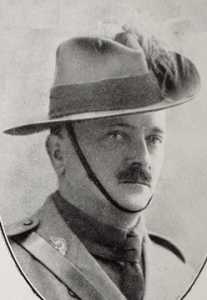 LTCOL Harris served at the Chairman of the QRA Council from 1911-1912. Harris was born 19th January 1871 at Dalby, Queensland and was educated at the Brisbane Grammar School from 1884 – 1886. Harris was married and worked as an Accountant and Secretary, and lived in Clayfield here in Brisbane. LTCOL Harris served in the Boer War and deployed to Gallipoli as the Commanding Officer, 5th Light Horse Regiment, Australian Imperial Force.
LTCOL Harris served at the Chairman of the QRA Council from 1911-1912. Harris was born 19th January 1871 at Dalby, Queensland and was educated at the Brisbane Grammar School from 1884 – 1886. Harris was married and worked as an Accountant and Secretary, and lived in Clayfield here in Brisbane. LTCOL Harris served in the Boer War and deployed to Gallipoli as the Commanding Officer, 5th Light Horse Regiment, Australian Imperial Force.
On the night of the 31st July, 1915 at 8pm, the 3rd infantry Brigade attacked the Turkish trenches. Lieutenant Colonel Harris, took up a position in the machine-gun observation post.
This attack provoked heavy shell fire from the Turks. One shell exploded about the machine gun observation post. A bullet entered the loop-hole and struck Lieutenant Colonel Harris on the neck. He died within two minutes. …On the 1st August Colonel Harris was buried on Shell Green at 9.15 pm, the ceremony being conducted by the Dean of Sydney and the Reverend Robertson.
MAJOR HUGH QUINN
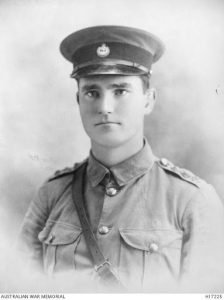 A prominent Great War soldier from North Queensland was Major Hugh Quinn, 15th Battalion, AIF. At the time of his enlistment, Hugh Quinn was resident in Townsville where he conducted his own business as a commission agent. Major Quinn was born in Charters Towers on 6th May 1888 and was educated at the Millchester State School and later at what is now known as The Southport School. He was a private in the Kennedy Regiment when the regiment was mobilised and sent on garrison duty to Thursday Island. He was one of several hundred men who volunteered to enlist in the 2nd Infantry, Australian Naval and Military Expeditionary Force. After this force was demobilised on its return to Australia from Thursday Island and New Guinea, Quinn applied for and was granted a commission in the Australian Imperial Force.
A prominent Great War soldier from North Queensland was Major Hugh Quinn, 15th Battalion, AIF. At the time of his enlistment, Hugh Quinn was resident in Townsville where he conducted his own business as a commission agent. Major Quinn was born in Charters Towers on 6th May 1888 and was educated at the Millchester State School and later at what is now known as The Southport School. He was a private in the Kennedy Regiment when the regiment was mobilised and sent on garrison duty to Thursday Island. He was one of several hundred men who volunteered to enlist in the 2nd Infantry, Australian Naval and Military Expeditionary Force. After this force was demobilised on its return to Australia from Thursday Island and New Guinea, Quinn applied for and was granted a commission in the Australian Imperial Force.
Major Quinn was a member of the North Queensland’s Kennedy Regiment Rifle Club (KRRC) and was at one time the club handicapper.
Major Quinn travelled to Gallipoli with the 15th Battalion where he saw considerable action. Quinn and his men were ordered to hold a position which initially was a communications trench and eventually became a heavily contested position. Over a period of a week Quinn and his men held off repeated attacks. On 29th May the Turks detonated a mine under or near the Australian position killing many of Quinn’s men. The Turks took advantage of the confusion that followed and rushed Quinn’s position over-running it. Quinn lead a counter attack which forced most but not all of the Turks to retreat. Quinn was further ordered to launch an attack over open ground to clear the position of the remaining Turks.
Major Quinn was killed on 6th June 1915 while undertaking a reconnaissance to retake the position. He was shot in the head which resulted in his immediate death. Quinn was buried at the New Monash Valley by Reverend J Green.
Quinn’s Post became known as the most contested position in the Anzac line. Several other rifle club members from Queensland were also killed at Quinn’s Post.
LIEUTENANT HERBERT GERALD HINTON
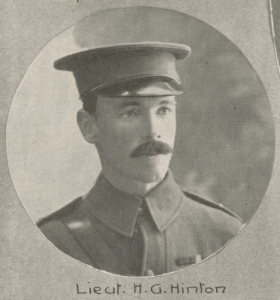 Herbert Gerald Hinton was born in Queensland (probably Brisbane) on 23 February 1879, the second son and one of seven children of John Edward Hinton (soldier and Superintendent of the Metropolitan Fire Brigade) and Mary Elizabeth Hinton (nee O’Reilly) of Graceville. He was educated at Boys Central State School and later gained employment in the pearl industry on Thursday Island then as a salesman in Brisbane and finally as a commercial traveller.
Herbert Gerald Hinton was born in Queensland (probably Brisbane) on 23 February 1879, the second son and one of seven children of John Edward Hinton (soldier and Superintendent of the Metropolitan Fire Brigade) and Mary Elizabeth Hinton (nee O’Reilly) of Graceville. He was educated at Boys Central State School and later gained employment in the pearl industry on Thursday Island then as a salesman in Brisbane and finally as a commercial traveller.
He was also a citizen soldier, serving in the ranks with Queensland Volunteer Rifles and Queensland Field Artillery. Private Hinton was also a keen and capable shooter, a member of QVR’s second rifle team on 24 August 1896, and a member of No 2 Battery Queensland Field Artillery Rifle Club in the late 1890s and early 1900s.
Hinton served in the Boer War, being selected as a private (sometimes called trooper) in the First (Queensland Mounted Infantry) Contingent on 28 October 1899.
Hinton re-joined the militia in about 1912, serving two years with 2nd Light Horse. On the outbreak of the Great War he volunteered for the AIF and was appointed to 2nd Light Horse Regiment (a unit of 1st Light Horse Brigade). Second Lieutenant Hinton passed his promotion examination on 28 October 1914 and was promoted to Lieutenant on 1 February 1915.
On 13 May the regiment relieved the 15th Battalion at Quinn’s Post. Lieutenant Hinton was slightly wounded in the eye on 14 May but returned to duty. At Quinn’s Post with the Turkish line a mere 15 yards away, inexperience saw early heavy casualties among 2nd Light Horse Regiment (2LHR). Following the failure of an attack by the regiment on 15 May, it was relieved by 15th Battalion and a system of 48-hour rotation of units through the post was introduced. A heavy operation was commenced on 6 August with attacks planned in several locations including Quinn’s Post, Pope’s, Russell’s Top, and German Officers’ Trench. 2LHR’s task was to capture Turkish trenches opposite Quinn’s Post. 2LHR attacked at 4.30am on 7 August 1915. My great uncle, also a member of the 2nd Light Horse Regiment, served with Lieutenant Hinton on the Gallipoli Peninsular at Quinn’s Post at this time. The troops were to emerge from tunnels preceded by preparatory activities including the taking of other objectives, the firing of a mine, the provision of artillery support and the element of surprise. An extract from a diary states:
As the troops scrambled from the trenches, intense fire was opened upon them. One Turkish machine-gun was shooting from the direct front, two from Dead Man’s Ridge, and a fourth from German Officers’. Major Logan, who led the line, was killed before he had gone five yards. ….With one exception, every man of the first line was killed or wounded, the majority before they had gone six yards. Many owed their lives to the fact that they were struck when on the parapet and fell back wounded into the trench. …In this action Major Logan, Lieutenants Burge and Hinton, and 14 others had been killed.
Herbert Gerald Hinton was 36 years old when he was killed on 7 August 1915. He left a widow and four young children, then residing at Sandgate. Lieutenant Hinton now lies in Shrapnel Green Cemetery.
Incredibly, my great uncle survived the August Offensive and the Gallipoli campaign.
LIEUTENANT HUTTON PERKINS ARMSTRONG
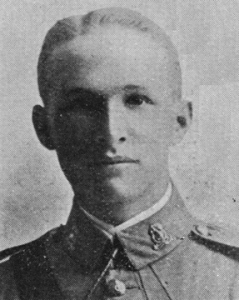 Lieutenant Armstrong was born on 24th February 1891 in Townsville and enlisted in Townsville on 14th August 1914. He was educated at the Townsville State School Technical College and was later employed as a Shipping Clerk.
Lieutenant Armstrong was born on 24th February 1891 in Townsville and enlisted in Townsville on 14th August 1914. He was educated at the Townsville State School Technical College and was later employed as a Shipping Clerk.
Hutton Armstrong was a member of the Townsville Rifle Club and won the 1908 NQRA Kings Prize. In 1913 he represented Australia at Bisley. He was one of several hundred men who volunteered to enlist in the 2nd Infantry, Australian Naval and Military Expeditionary Force. After this force was demobilised on its return to Australia from Thursday Island and New Guinea, he joined the AIF and was promoted to Lieutenant on 25 March 1915 before arriving at Gallipoli.
Armstrong joined 15th Battalion at Gallipoli and is expected to have known Hugh Quinn as both lived in Townsville, both were rifle shooters and both were members of the Australian Naval and Military Expeditionary Force for the deployment to Papua New Guinea.
Lieutenant Armstrong was killed at Quinn’s Post on the Gallipoli Peninsular on 10th May 1915. A private letter written by SGT J Craven stated “‘The ‘Major’, as he was called, was killed while gallantly holding a trench which he first charged and captured. He was well respected and a splendid shot.” Armstrong was buried at Quinn’s Post.
SAPPER JAMES ARCHIBALD LINDSAY
 Sapper James Lindsay was a fitter who was born in Ipswich and assumed to have attended school in Ipswich. He was a member of the Ipswich Railway and District Rifle Club. James Lindsay enlisted on 22nd August 1914 and served on Gallipoli as a Sapper with the 3rd Field Company Engineers.
Sapper James Lindsay was a fitter who was born in Ipswich and assumed to have attended school in Ipswich. He was a member of the Ipswich Railway and District Rifle Club. James Lindsay enlisted on 22nd August 1914 and served on Gallipoli as a Sapper with the 3rd Field Company Engineers.
Sapper Lindsay was killed at Gallipoli on 10th May 1915, the same day as Lieutenant Armstrong from Townsville. He was buried at Courtney’s and Steel’s Post Cemetery.
I will conclude with an example of Cold Blooded Courage displayed by a rifle club member who did not serve at Gallipoli but died ensuring the initiative displayed during the Gallipoli campaign did not result in further own troop casualties on the Western Front.
SERGEANT DAVID EMMETT COYNE
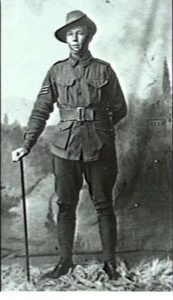 David Emmett Coyne was born in March 1896 at Marian near Mackay in North Queensland. David Coyne was a farmer by profession and active member of the Marian Rifle Club at the outbreak of the Great War. At age 20, in May 1916 Coyne sailed for Europe with members of the 31st Battalion, the Kennedy Regiment.
David Emmett Coyne was born in March 1896 at Marian near Mackay in North Queensland. David Coyne was a farmer by profession and active member of the Marian Rifle Club at the outbreak of the Great War. At age 20, in May 1916 Coyne sailed for Europe with members of the 31st Battalion, the Kennedy Regiment.
Coyne commenced his Army career as a private and over time rose to the rank of Sergeant. Coyne was considered an expert in the use of Mills Bombs, more commonly called hand grenades. Coyne and his platoon guarded an important section of trench which attracted much attention from a German Machine Section.
Coyne planned to move out on the night of 15th May 1918 to bomb the German position. In preparation for the assault he was testing a recently arrived consignment of Mills Bombs to assess the consignments reliability. Experience from the Gallipoli Campaign suggested bombs or grenades, particularly those made in the trenches were problematic in that some fuses were instantaneous. In order to carry out the test he planned to throw a bomb over the trench parapet into no-mans-land where it was expected to explode harmlessly.
In reality what happened is the Mills Bomb hit the parapet top and fell back into the trench among Coyne’s platoon. Coyne yelled to his platoon “run for your lives boys” and then proceeded to try and find the bomb in the dark trench. Initially the search was unsuccessful and by the time he had located the bomb its time fuse had all but expired leaving no time to throw the menacing bomb over the parapet.
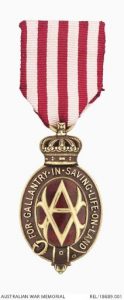
Coyne took the decision to throw himself onto the bomb knowing full well what the likely outcome was. Sergeant Coyne received fatal injuries as the result of the explosion but saved his platoon by his action. This selfless action of what has been described as cold blooded courage initially led to a recommendation for the Victoria Cross. After due consideration, the recommendation for the Victoria Cross was changed and Coyne was awarded the Albert Medal in Gold. The Albert Medal was named after Queen Victoria’s husband, Albert. The decision to award the Albert Medal in Gold, the only one awarded to AIF troops in the Great War, had its foundation in the fact in that this act of bravery was not taken in the face of the enemy, a requirement for the awarding of the Victoria Cross. In 1949 the Albert Medal in Gold was replaced with the George Cross.
Sergeant Coyne is interred at Vignacourt British Cemetery, Amiens, France.
Today, ANZAC Day is set aside for us to remember those who have served our country in all conflicts, to reflect upon their unselfish service and to embrace the history that has define our country – at this time each year we keep that history alive through reflecting on the past.
5,316 members of rifle clubs in Queensland answered the call and enlisted for service during the Great War. 568 paid the ultimate sacrifice so we could enjoy the freedoms that exist today.
LEST WE FORGET
Information contained within this speech has been gathered from:
- Ray McNab’s Note 1 for the 2017 European Battlefield Tour
- QRA’s History – ‘Home on the Range’
- NQRA’s History – ‘So You Went Target Rifle Shooting’ to be launched on 17 May 2019
- Australian National Archives
Quick Links
Our Location
Belmont Shooting Complex
- 1485 Old Cleveland Road, Belmont Qld, 4153
- PO Box 38, CARINA QLD 4152
- 07 3398 4309
- qra@qldrifle.com
- Duncan Range Standing Orders - Refer to the office
- GIVEITASHOT & FSC registration is via RevolutioniseSport management
Quick Links
About Us
The Queensland Rifle Association fosters target rifle shooting and firearms training through our clubs. Different classes of rifle shooting are conducted by our Clubs under the Standard Shooting Rules (SSRs) of the National Rifle Association of Australia (NRAA).
NRAA Quicklinks
Our Location
Belmont Shooting Complex
- 1485 Old Cleveland Road, Belmont Qld, 4153
- PO Box 38, CARINA QLD 4152
- 07 3398 4309
- qra@qldrifle.com
- Duncan Range Standing Orders - Refer to the office
- GIVEITASHOT & FSC registration is via RevolutioniseSport management
